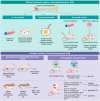Chondrosarcoma: New Molecular Insights, Challenges in Near-Patient Preclinical Modeling, and Therapeutic Approaches
- PMID: 40004005
- PMCID: PMC11855192
- DOI: 10.3390/ijms26041542
Chondrosarcoma: New Molecular Insights, Challenges in Near-Patient Preclinical Modeling, and Therapeutic Approaches
Abstract
Chondrosarcoma (CS), the second most common malignant bone tumor after osteosarcoma, accounts for 20-30% of all malignant bone tumors. It mainly affects adults, middle-aged, and elderly people. The CS family includes various entities displaying peculiar biological, genetic, and epigenetic characteristics and clinical behaviors. Conventional CS is the most common subtype. High-grade, dedifferentiated, and mesenchymal CS, as well as unresectable and metastatic CS, exhibit poor prognoses due to their intrinsic resistance to radiotherapy and chemotherapy, underscoring the urgent need for novel therapeutic strategies. CS research is dealing with several challenges. Experimental studies can rely on animal and patient-derived models, but the paucity of representative near-patient preclinical models has hampered predictive drug screening research. This review describes the main clinical and molecular features of CS subtypes, discussing recent data on the genetic alterations and molecular mechanisms involved in CS pathogenesis and progression. The review provides an overview of the current in vitro and in vivo CS models, discusses their advantages and limitations, and highlights the recent efforts in the development of new targeted therapies against CS dependencies, including IDH1/2 mutations, NAD+ dependency, and SIRT1-HIF-2α axis, or exploring DR5 targeting, antiangiogenic therapies, epigenetic drugs, and immunological approaches. All such strategies, in combination with advanced preclinical modeling and personalized multi-omic profiling, hold promise for improving the survival of patients with advanced CS.
Keywords: chondrosarcoma; immunotherapy; multi-omic profiling; preclinical models; targeted therapies.
Conflict of interest statement
The authors declare no conflicts of interest.
Figures

References
-
- Van Praag (Veroniek) V.M., Rueten-Budde A.J., Ho V., Dijkstra P.D.S., Fiocco M., Van De Sande M.A.J., Van Der Geest I.C., Bramer J.A., Schaap G.R., Jutte P.C., et al. Incidence, outcomes and prognostic factors during 25 years of treatment of chondrosarcomas. Surg. Oncol. 2018;27:402–408. doi: 10.1016/j.suronc.2018.05.009. - DOI - PubMed
Publication types
MeSH terms
LinkOut - more resources
Full Text Sources
Medical
Miscellaneous

